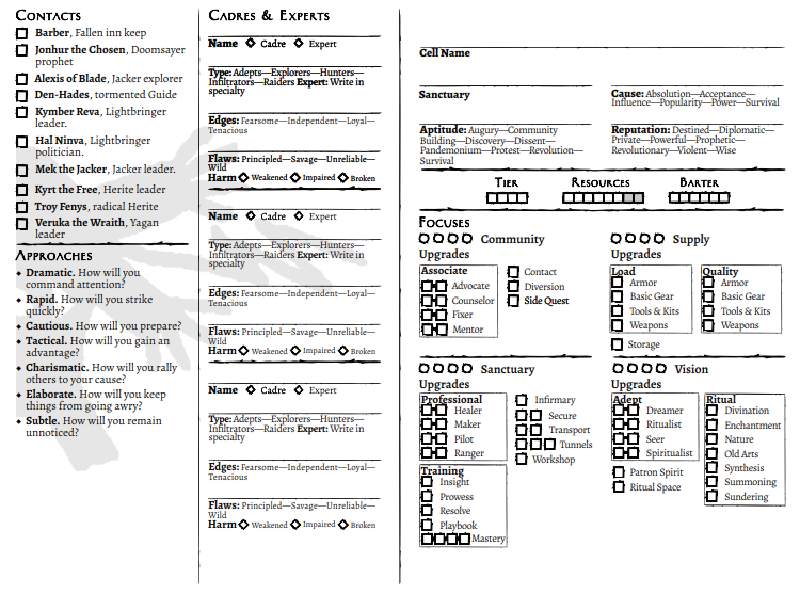Like many Forged in the Dark games, Tribes in the Dark features a sheet and mechanics for the group in which the player characters find themselves. This is, naturally, a Fallen Cell—the quasi-political unit and found family that the Fallen gravitate towards forming. Along with the playbooks, coming up with the dynamics of how Cells work was a lot of work and something I’m pretty proud of. It was one of the things that I felt was sorely missing from earlier editions of Tribe 8 and was one of the reasons we chose Forged in the Dark for the new version.
There are a few significant differences between how Cells function and, for example, crews in Blades in the Dark. The most important differences are claims/turf, special abilities, and tier.
Cells don’t have claims at all. This might seem somewhat counterintuitive, but crews operate as criminal gangs. In contrast, a Fallen Cell focuses more on survival and, later, political maneuvering. Also, there simply isn’t enough turf to go around on the island that the Fallen occupy, Hom. Because there aren’t different types of Cells—while there could be a Cell comprised of characters that are all the same Outlook, that isn’t the norm—it didn’t make much sense to have special abilities like BitD crews do. In place of special abilities and claims, Cells have a group of four traits that function like attributes called Focuses. The Focuses are: Community, Sanctuary, Supply, and Vision. Each Focus encompasses a different aspect of the Cell’s strengths, functioning as individual facets of what comprises tier for a Blades in the Dark crew. For example, Community is important when pursuing your character’s diversion to clear stress, and Vision impacts the power and complexity of Synthesis use. Sanctuary can be used for rolls to defend the Cell’s home, and Supply provides improvements and upgrades to gear that the Cell has access to. Each Focus also has various upgrades that the Cell can purchase.
The other significant departure from Blades in the Dark is the Cell’s tier isn’t improved directly. Cell tier is a direct function of the tiers of the four Fallen Outlook factions—specifically, it’s equal to the lowest of the faction tiers. For the player character Cell to improve its tier, they must undertake quests for all of the Outlooks to advance their goals. This is a relatively slow process, but it’s designed so that when all of the Fallen Outlooks have reached tier IV, they are major forces on Vimary. The player character Cell is a powerhouse at the forefront. The Cell can undertake quests to accomplish the goals of other factions, such as one of the Seven Tribes or even the Z’bri, and even receive rewards (called boons) not available from different factions. Still, in the end, it will do nothing to advance the Fallen’s goals.
Cells can even grow in size, incorporating cadres of NPCs tailored to the Cell’s Outlook affiliations and individual experts recruited based on the Cell’s Focuses. There are also some other minor changes, such as not tracking heat and (technically) not having a coin stash. The end result hopefully simplifies the Cell and focuses them more on interactions withthe factions and the political game, versus building up a criminal empire.
Just as there is the possibility of other playbooks representing Tribals, “natural born” Fallen of each of the Outlooks, outsiders such as Keepers and Outlanders, and even the Lost Tribes of Mary and Joshua, the framework used for Cells will likely be expanded to include other similar groups, such as Tribal Circles. But the focus, at least for Tribes in the Dark, is on the Fallen, so it is the Cells that get top billing for the time being.
